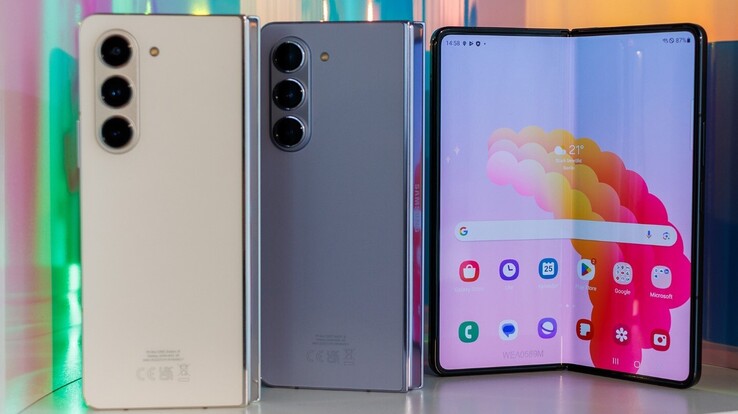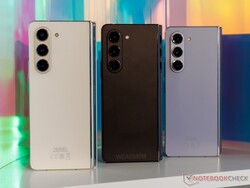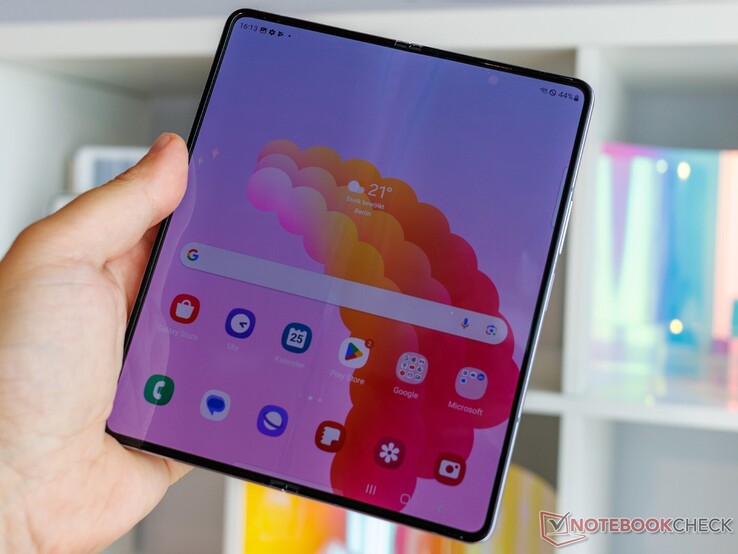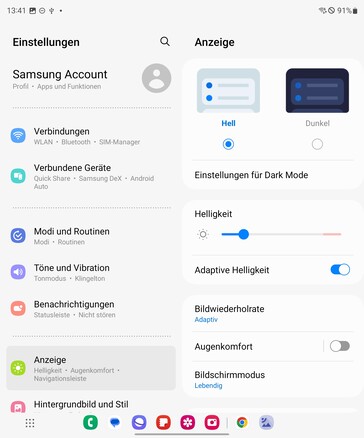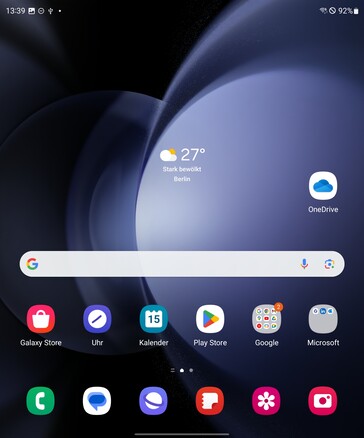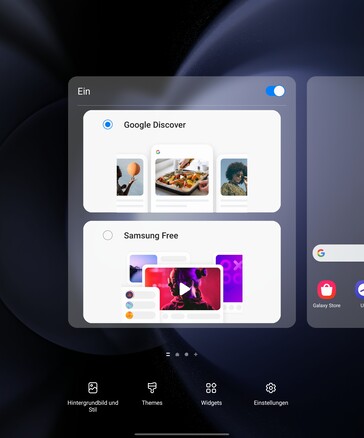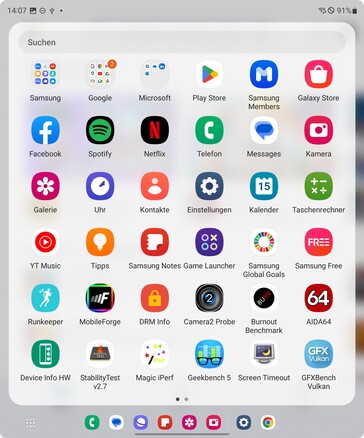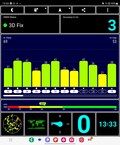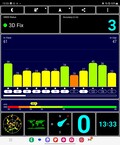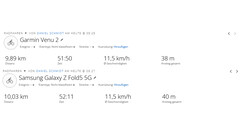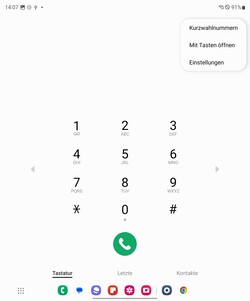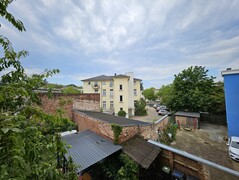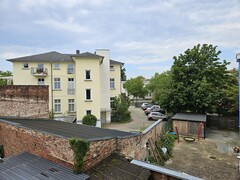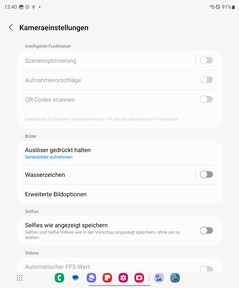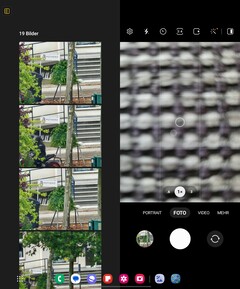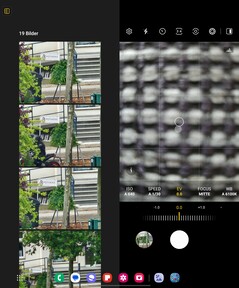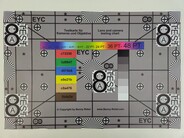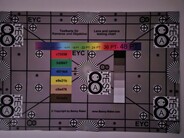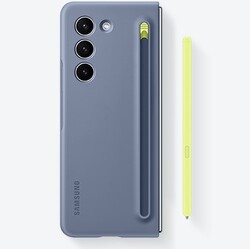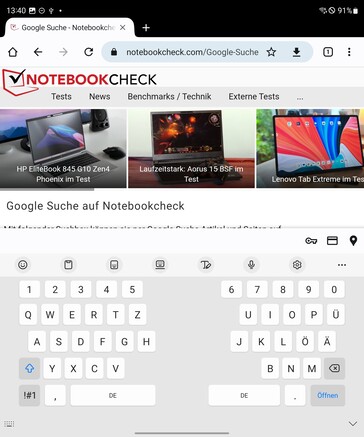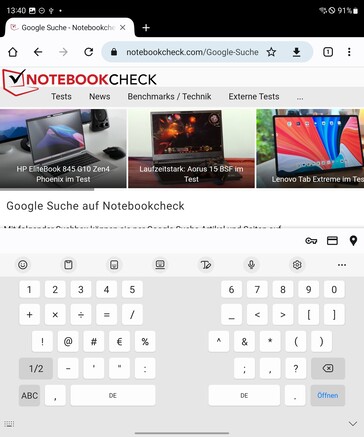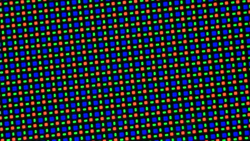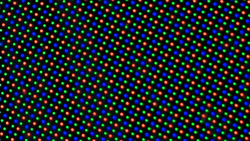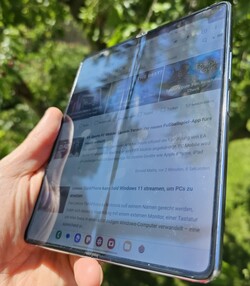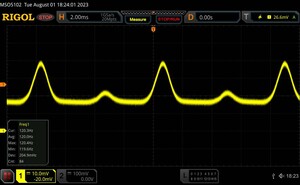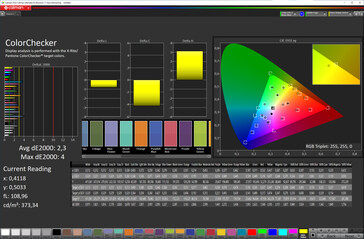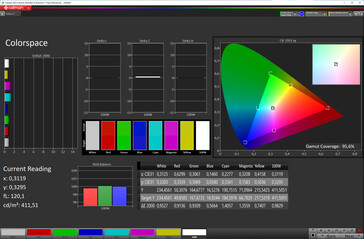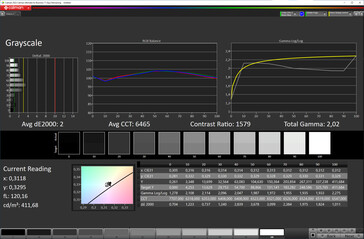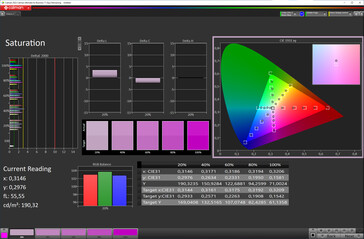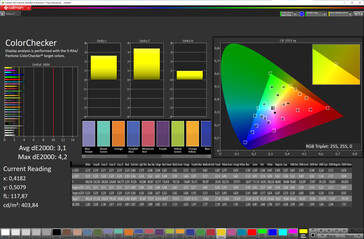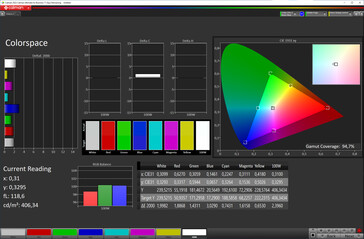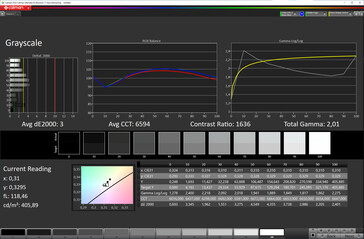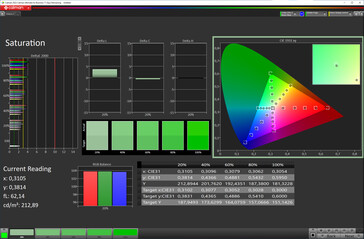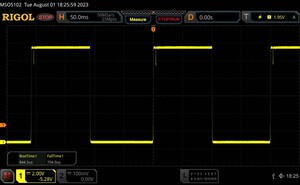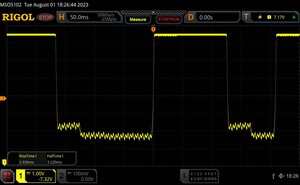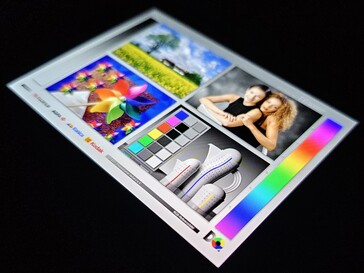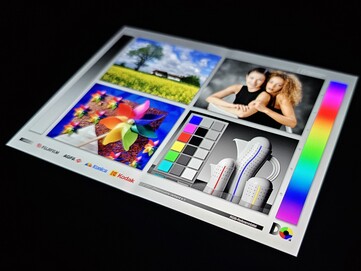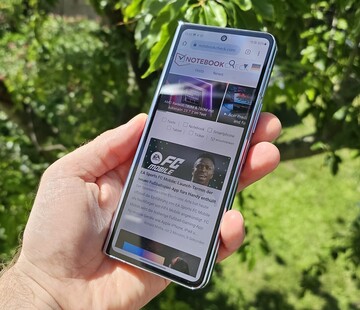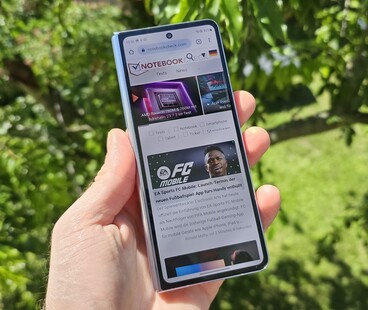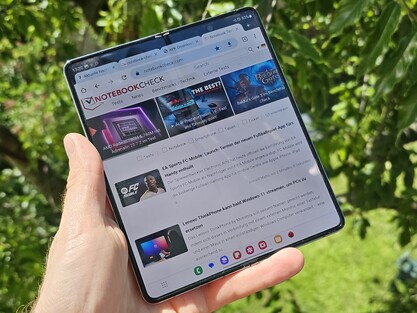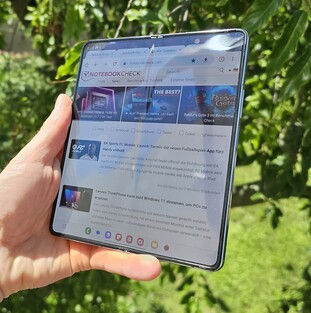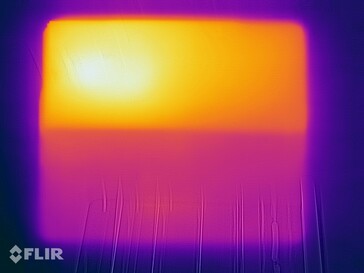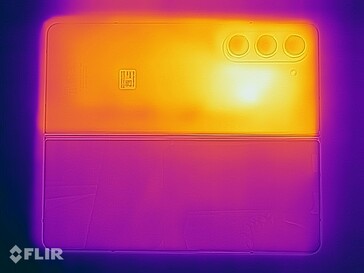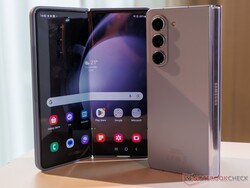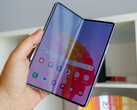Samsung Galaxy Z Fold5 review - Small steps toward being the best foldable smartphone?
At its Galaxy Unpacked Event in July this year, Samsung announced the fifth generation of its XXL foldable. The Galaxy Z Fold4's successor is the slimmest and lightest Fold in the Galaxy Z series so far. However, you have to look very closely to identify differences between both smartphone models. The main screen continues to measure 7.6 inches and has a 21.6:18 aspect ratio with the front display measuring 6.2 inches and possessing a 23.1:9 aspect ratio. The new Flex hinge allows the Fold5 to be folded almost completely without a large gap and is the most obvious innovation.
Apart from that, with its Snapdragon 8 Gen 2 for Galaxy, the Galaxy Z Fold5 offers more efficiency and higher performance than the previous year's Qualcomm SoC found in its predecessor. No adjustments have been made in terms of the basic concept or design of the Foldable series. Also, the installed cameras don't differ from the Fold4 setup and benefit at most from the new Snapdragon ISP.
Possible competitors compared
Rating | Date | Model | Weight | Drive | Size | Resolution | Price |
|---|---|---|---|---|---|---|---|
| 89.1 % v7 (old) | 08 / 2023 | Samsung Galaxy Z Fold5 SD 8 Gen 2 for Galaxy, Adreno 740 | 253 g | 256 GB UFS 4.0 Flash | 7.60" | 2176x1812 | |
| 89.8 % v7 (old) | 10 / 2022 | Samsung Galaxy Z Fold4 5G SD 8+ Gen 1, Adreno 730 | 263 g | 256 GB UFS 3.1 Flash | 7.60" | 2176x1812 | |
| 84.7 % v7 (old) | 08 / 2023 | Google Pixel Fold Tensor G2, Mali-G710 MP7 | 283 g | 256 GB UFS 3.1 Flash | 7.60" | 2208x1840 | |
| 86.3 % v7 (old) | 06 / 2023 | Huawei Mate X3 SD 8+ Gen 1, Adreno 730 | 239 g | 512 GB UFS 3.1 Flash | 7.85" | 2496x2224 | |
| 91.1 % v7 (old) | 03 / 2023 | Samsung Galaxy S23 Ultra SD 8 Gen 2 for Galaxy, Adreno 740 | 233 g | 256 GB UFS 4.0 Flash | 6.80" | 3080x1440 |
Case - The Samsung Galaxy Z Fold5 with improved UDC
The Galaxy Z Fold5 is available in the colors Phantom Black, Icy Blue and Cream as well as the Samsung online shop exclusive colors, Blue and Gray. With a case width of 6.1 mm when opened, the Galaxy Z Fold5 is only 0.2 millimeters slimmer than the previous generation. Nevertheless, the newest Fold fledgling feels noticeably thinner thanks to its newly developed hinge design which lacks the gap found in the Fold4. However, at over 13 millimeters, the Galaxy Z Fold5 is clearly thicker than an 11-millimeter-thick Huawei Mate X3 or a 10-millimeter-thick Honor Magic V2.
In comparison to the foldable competition from Honor, the Fold5 still continues to enjoy one big advantage in that the case is officially IPX8 certified. This protects the device when continually submerged in water at a depth of 1.5 meters for up to 30 minutes. In addition to the IPX8 protection class, the Korean manufacturer also promotes its Foldable's resilience with the Fold5's main display being covered by a shock-absorbing layer and both the front and rear displays enjoying protection in the form of Corning Gorilla Glass Victus 2. Also, the double-track structure of the freely adjustable Flex hinge is said to be more successful at absorbing bumps. As well as this, we also have the familiar Armor aluminum frame.
The build quality is on a very high level and, in comparison to the Fold4, the angular transition between the hinge and the glass elements has been significantly improved. The Galaxy Fold5's Under-Display camera (UDC) now possesses more subpixels in the display matrix than we saw in the previous generation model, however, on closer inspection, the mosaic pattern is still visible. But, even with a white background, the UDC and its thinned-out sub pixels are no longer as bothersome.
Features - A Samsung smartphone with a 1 TB option
The Galaxy Z Fold5 comes in the following three variants and with Bluetooth 5.3, NFC, a UWB chip as well as Miracast, it offers a wide selection of features:
Galaxy Z Fold5 | 12 GB LPDDR5x RAM | 256 GB UFS 4.0 storage | $1,799 (RRP)
Galaxy Z Fold5 | 12 GB LPDDR5x RAM | 512 GB UFS 4.0 storage | $1,919 (RRP)
Galaxy Z Fold5 | 12 GB LPDDR5x RAM | 1 TB UFS 4.0 storage | $2,159 (RRP) - exclusively in Samsung's online shop.
The Korean manufacturer's foldable comes with the fast USB 3.2 (Gen. 1) standard which also provides USB OTG in addition to wired video output via the HDMI or DisplayPort interfaces. In our copy test using a connected M2.SSD hard drive (Samsung 980 Pro), the USB port achieved transfer speeds of 214 MB/s. Samsung DeX's desktop mode is also supported and can be used either wirelessly or via an optional cable.
Software - Long-term updates for the Samsung Galaxy Z Fold5
The Samsung Galaxy Z Fold5 comes with Google Android 13 and its in-house One UI 5.1.1. In addition to the focus on multi-tasking, as well as an app bar, three applications can now be opened on the display simultaneously.
During the testing period, the Samsung foldable's operating system was based on the security patches from July 2023 with the promise of updates until 2028. The Galaxy phone will receive operating system updates for four generations up to Android 17. The long-term software update support is a big plus point for the Galaxy Z Fold5 and no other foldable offers more – not even the Google Pixel Fold.
Communication and GNSS - The Galaxy smartphone has 5G
With WiFi 6E, the Samsung offers high transfer speeds, however, there are already smartphones on the market that support the current WiFi 7 standard. With our reference router, the Asus ROG Rapture GT-AXE11000, the Galaxy Z Fold5 achieves around 1,600 MBit/s in the 6 GHz range and roughly 900 MBit/s at 5 GHz. The high transfer speeds are also mostly stable. In addition, the Galaxy Z Fold5 supports all of the current mobile communication standards including 5G Sub6 with the exception of 5G mmWave. The frequency coverage is also extensive.
| Networking | |
| Samsung Galaxy Z Fold5 | |
| iperf3 receive AXE11000 | |
| iperf3 transmit AXE11000 | |
| iperf3 transmit AXE11000 6GHz | |
| iperf3 receive AXE11000 6GHz | |
| Samsung Galaxy Z Fold4 5G | |
| iperf3 receive AXE11000 | |
| iperf3 transmit AXE11000 | |
| Google Pixel Fold | |
| iperf3 receive AXE11000 | |
| iperf3 transmit AXE11000 | |
| iperf3 transmit AXE11000 6GHz | |
| iperf3 receive AXE11000 6GHz | |
| Huawei Mate X3 | |
| iperf3 receive AXE11000 | |
| iperf3 transmit AXE11000 | |
| Samsung Galaxy S23 Ultra | |
| iperf3 receive AXE11000 | |
| iperf3 transmit AXE11000 | |
| iperf3 transmit AXE11000 6GHz | |
| iperf3 receive AXE11000 6GHz | |
| Average of class Smartphone | |
| iperf3 receive AXE11000 | |
| iperf3 transmit AXE11000 | |
| iperf3 transmit AXE11000 6GHz | |
| iperf3 receive AXE11000 6GHz | |
In order to be able to evaluate the location accuracy in real-world situations, we took the foldable smartphone on a short trip. For comparison purposes, we simultaneously recorded the route with a Garmin Venu 2. We were not entirely impressed with the Galaxy Z Fold5's location accuracy in our GPS test. In the area of our turning loop, the Samsung smartphone seemed to have problems with the satellite connection which meant noticeable deviations from the chosen route could be seen in the detailed analysis.
Telephone functions and voice quality - The Galaxy Z Fold5 comes with eSIM
The Galaxy Z Fold5 supports VoLTE and Wi-Fi calls as well as dual SIM functionality with two Nano SIM cards or, alternatively, an eSIM can also be activated. The voice quality is very good and voices are reproduced clearly. Our caller also described the voice transmission using the Samsung smartphone as clear.
Cameras - The triple camera Samsung smartphone
Once again, Samsung has hidden a 4 MP Under-Display camera under the main display. With the help of multi-frame synthesis technology and AI-based algorithms, the manufacturer has aimed to improve the image sharpness compared to the predecessor. And, this is something we can also confirm based on our Galaxy Z Fold5 test photos. Nevertheless, the external display's 10 MP hole-punch camera clearly continues to deliver more balanced results. However, anyone with a suitable location at hand should sit the device flipped open and use the main camera and also the front panel as a viewfinder.
The unchanged Fold4 50 MP main camera impressed us with good dynamics and appealing sharpness. The Galaxy Z Fold displayed successful color reproduction both in the test photos and also under controlled lighting conditions, although, the green tones are a little too dazzling.
The ultra wide-angle lens and also the 10 MP OIS telephoto camera are rock-solid but we weren't really impressed by the zoom levels above 3x magnification. The 12 MP camera did better when it came to very wide-angled photos. In this area, details are better preserved.
Image comparison
Choose a scene and navigate within the first image. One click changes the position on touchscreens. One click on the zoomed-in image opens the original in a new window. The first image shows the scaled photograph of the test device.
WeitwinkelWeitwinkelLow LightUltraweitwinkelZoom 5x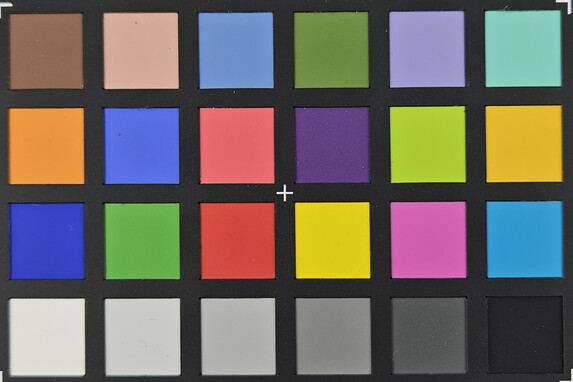
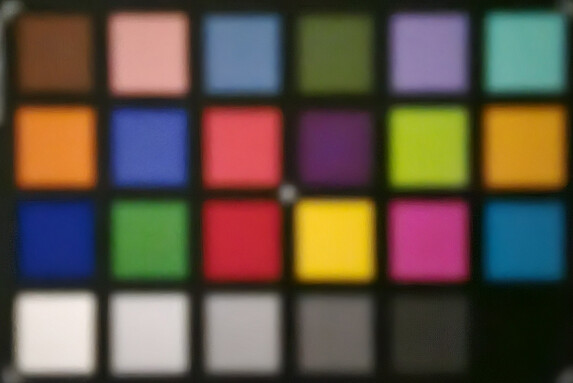
Accessories and guarantee - The Galaxy Z Fold5 comes without a charger
Ou-of-the-box, the Galaxy Z Fold5 comes without a charger, however, a data or charging cable (USB-C to USB-C) and a SIM tool are included. Optionally, Samsung offers a large selection of matching cases, including a Slim S Pen Case, the Clear Gadget Case, an Eco-Leather Case as well as a Standing Cover with a strap.
In Germany, Samsung provides the cell phone with a 24-month guarantee. In addition, one year of Care+ comes with the purchase of a Fold5.
Input devices & operation - The S Pen Samsung smartphone
While the outer 6.2-inch OLED panel is protected by Corning Gorilla Glass Victus 2, the Fold5's inner display and its foldable glass material continue to be covered with a permanent protective film. Both displays are responsive. The flex mode is supported by the new hinge design at angles between 75° and 115° and appears to be very solid.
Just like the Fold4 predecessor, the fingerprint sensor is built into the power-on button and unlocks the Samsung cell phone very reliably. The rather unsafe 2D face recognition, which uses both the front camera and Under-Display camera for its FaceUnlock function, works just as reliably in everyday use.
Unlike the Galaxy S23 Ultra, there is no space for the S Pen in the Fold edition of the foldable smartphone. Unfortunately, Samsung has also opted against providing the outer display with stylus support and is something users may find annoying in day-to-day use.
Display - The Galaxy Z Fold5 has a foldable OLED
The highlight of the Fold5, the 7.6-inch, flexible Dynamic AMOLED panel with a dynamic refresh rate from 1 to 120 Hz, reached a peak brightness of 1,674 cd/m² (APL18) in our tests. However, we measured this to be around 200 cd/m² more than the predecessor, even with a completely, corner-to-corner white display. The crease in the area of the fold is still clearly visible but is a little less prominent than the one seen in the Fold4.
When it comes to brightness, the tall, 6.2-inch front panel, with its refresh rate from 48 to 120 Hz, didn't quite match the main screen's values. At 957 cd/m², we measured almost identical maximum luminance to that of the Fold4.
The Fold5 is unable to avoid PWM flickering as a result of both displays' OLED technology. At low brightness (< 45 percent), this takes place at a constant 120 Hz and, if the brightness is increased, it happens at a constant 240 Hz.
| |||||||||||||||||||||||||
Brightness Distribution: 97 %
Center on Battery: 1104 cd/m²
Contrast: ∞:1 (Black: 0 cd/m²)
ΔE ColorChecker Calman: 3.1 | ∀{0.5-29.43 Ø4.77}
ΔE Greyscale Calman: 3 | ∀{0.09-98 Ø5}
94.7% sRGB (Calman 2D)
Gamma: 2.01
CCT: 6594 K
| Samsung Galaxy Z Fold5 Dynamic AMOLED, 2176x1812, 7.6" | Samsung Galaxy Z Fold5 Dynamic AMOLED, 2316x904, 6.2" | Samsung Galaxy Z Fold4 5G Dynamic AMOLED, 2176x1812, 7.6" | Google Pixel Fold OLED, 2208x1840, 7.6" | Huawei Mate X3 OLED, 2496x2224, 7.9" | Samsung Galaxy S23 Ultra Dynamic AMOLED 2x, 3080x1440, 6.8" | |
|---|---|---|---|---|---|---|
| Screen | 6% | 13% | 14% | 18% | 10% | |
| Brightness middle (cd/m²) | 1104 | 957 -13% | 913 -17% | 993 -10% | 948 -14% | 1117 1% |
| Brightness (cd/m²) | 1107 | 958 -13% | 929 -16% | 997 -10% | 969 -12% | 1133 2% |
| Brightness Distribution (%) | 97 | 97 0% | 96 -1% | 94 -3% | 94 -3% | 97 0% |
| Black Level * (cd/m²) | ||||||
| Colorchecker dE 2000 * | 3.1 | 2.3 26% | 1.7 45% | 1.4 55% | 1.4 55% | 2.2 29% |
| Colorchecker dE 2000 max. * | 4.2 | 4 5% | 3.6 14% | 3.2 24% | 2.6 38% | 3.9 7% |
| Greyscale dE 2000 * | 3 | 2 33% | 1.5 50% | 2.1 30% | 1.7 43% | 2.3 23% |
| Gamma | 2.01 109% | 2.02 109% | 2.16 102% | 2.24 98% | 2.15 102% | 2.37 93% |
| CCT | 6594 99% | 6465 101% | 6515 100% | 6796 96% | 6539 99% | 6572 99% |
* ... smaller is better
Screen Flickering / PWM (Pulse-Width Modulation)
| Screen flickering / PWM detected | 120 Hz | ||
The display backlight flickers at 120 Hz (worst case, e.g., utilizing PWM) . The frequency of 120 Hz is very low, so the flickering may cause eyestrain and headaches after extended use. In comparison: 53 % of all tested devices do not use PWM to dim the display. If PWM was detected, an average of 8084 (minimum: 5 - maximum: 343500) Hz was measured. | |||
A series of measurements with a fixed level of zoom and various brightness settings
We analyzed the color calibration of the HDR10+ certified AMOLED panel using the Calman analysis software and a photo spectrometer. Although the color deviations are in the target range (<3), the measured DeltaE values are higher than the competition. Overall, the quality on offer is very good but for a smartphone in this price category, the calibration could be somewhat more accurate.
Display Response Times
| ↔ Response Time Black to White | ||
|---|---|---|
| 1.55 ms ... rise ↗ and fall ↘ combined | ↗ 0.8445 ms rise | |
| ↘ 0.704 ms fall | ||
| The screen shows very fast response rates in our tests and should be very well suited for fast-paced gaming. In comparison, all tested devices range from 0.1 (minimum) to 240 (maximum) ms. » 8 % of all devices are better. This means that the measured response time is better than the average of all tested devices (20.2 ms). | ||
| ↔ Response Time 50% Grey to 80% Grey | ||
| 6.16 ms ... rise ↗ and fall ↘ combined | ↗ 2.936 ms rise | |
| ↘ 3.22 ms fall | ||
| The screen shows very fast response rates in our tests and should be very well suited for fast-paced gaming. In comparison, all tested devices range from 0.165 (minimum) to 636 (maximum) ms. » 18 % of all devices are better. This means that the measured response time is better than the average of all tested devices (31.6 ms). | ||
Outdoors and regardless of the display, the Fold5 makes a very positive impression and possesses sufficient brightness reserves to be able to handle most light situations. Likewise, the viewing angle stability is very good.
Performance - The Samsung phone has a Qualcomm SoC
When it comes to performance, the Samsung foldable smartphone looks to the speedy Snapdragon 8 Gen 2 for Galaxy, which puts on a good show in its own benchmarks. Especially with its Geekbench 6 multi-core score, the Fold5 offers significantly more power than the Google Tensor G2 in the Pixel Fold. But, with its Adreno 740, the Samsung device also performed very well, doing around 30 percent better than its predecessor. In GFXBench, the plus in performance compared to the Fold4 is not reflected in consistently higher scores, although, the cause here is more likely to be thermal problems and the accompanying throttling effects. The very low values seen in UL Procyon AI Inference are also striking.
| UL Procyon AI Inference for Android - Overall Score NNAPI | |
| Samsung Galaxy Z Fold4 5G | |
| Google Pixel Fold | |
| Average of class Smartphone (3769 - 81594, n=132, last 2 years) | |
| Samsung Galaxy S23 Ultra | |
| Average Qualcomm Snapdragon 8 Gen 2 for Galaxy (1267 - 16702, n=8) | |
| Samsung Galaxy Z Fold5 | |
GFXBench (DX / GLBenchmark) 2.7: T-Rex Onscreen | 1920x1080 T-Rex Offscreen
GFXBench 3.0: on screen Manhattan Onscreen OGL | 1920x1080 1080p Manhattan Offscreen
GFXBench 3.1: on screen Manhattan ES 3.1 Onscreen | 1920x1080 Manhattan ES 3.1 Offscreen
GFXBench: on screen Car Chase Onscreen | 1920x1080 Car Chase Offscreen | on screen Aztec Ruins High Tier Onscreen | 2560x1440 Aztec Ruins High Tier Offscreen | on screen Aztec Ruins Normal Tier Onscreen | 1920x1080 Aztec Ruins Normal Tier Offscreen | 3840x2160 4K Aztec Ruins High Tier Offscreen
| 3DMark / Wild Life Extreme Unlimited | |
| Samsung Galaxy Z Fold5 | |
| Samsung Galaxy S23 Ultra | |
| Samsung Galaxy Z Fold4 5G | |
| Huawei Mate X3 | |
| Google Pixel Fold | |
| 3DMark / Wild Life Extreme | |
| Samsung Galaxy Z Fold5 | |
| Samsung Galaxy S23 Ultra | |
| Huawei Mate X3 | |
| Samsung Galaxy Z Fold4 5G | |
| Google Pixel Fold | |
| 3DMark / Wild Life Unlimited Score | |
| Samsung Galaxy Z Fold5 | |
| Samsung Galaxy S23 Ultra | |
| Samsung Galaxy Z Fold4 5G | |
| Huawei Mate X3 | |
| Google Pixel Fold | |
| GFXBench (DX / GLBenchmark) 2.7 / T-Rex Onscreen | |
| Samsung Galaxy Z Fold4 5G | |
| Samsung Galaxy S23 Ultra | |
| Google Pixel Fold | |
| Samsung Galaxy Z Fold5 | |
| Huawei Mate X3 | |
| GFXBench (DX / GLBenchmark) 2.7 / T-Rex Offscreen | |
| Samsung Galaxy S23 Ultra | |
| Huawei Mate X3 | |
| Samsung Galaxy Z Fold5 | |
| Google Pixel Fold | |
| Samsung Galaxy Z Fold4 5G | |
| GFXBench 3.0 / Manhattan Onscreen OGL | |
| Samsung Galaxy S23 Ultra | |
| Samsung Galaxy Z Fold4 5G | |
| Samsung Galaxy Z Fold5 | |
| Huawei Mate X3 | |
| Google Pixel Fold | |
| GFXBench 3.0 / 1080p Manhattan Offscreen | |
| Samsung Galaxy S23 Ultra | |
| Huawei Mate X3 | |
| Samsung Galaxy Z Fold4 5G | |
| Samsung Galaxy Z Fold5 | |
| Google Pixel Fold | |
| GFXBench 3.1 / Manhattan ES 3.1 Onscreen | |
| Samsung Galaxy S23 Ultra | |
| Samsung Galaxy Z Fold4 5G | |
| Samsung Galaxy Z Fold5 | |
| Huawei Mate X3 | |
| Google Pixel Fold | |
| GFXBench 3.1 / Manhattan ES 3.1 Offscreen | |
| Samsung Galaxy S23 Ultra | |
| Huawei Mate X3 | |
| Samsung Galaxy Z Fold4 5G | |
| Samsung Galaxy Z Fold5 | |
| Google Pixel Fold | |
| GFXBench / Car Chase Onscreen | |
| Samsung Galaxy Z Fold4 5G | |
| Samsung Galaxy S23 Ultra | |
| Samsung Galaxy Z Fold5 | |
| Huawei Mate X3 | |
| Google Pixel Fold | |
| GFXBench / Car Chase Offscreen | |
| Samsung Galaxy S23 Ultra | |
| Huawei Mate X3 | |
| Samsung Galaxy Z Fold5 | |
| Samsung Galaxy Z Fold4 5G | |
| Google Pixel Fold | |
| GFXBench / Aztec Ruins High Tier Onscreen | |
| Samsung Galaxy Z Fold4 5G | |
| Samsung Galaxy Z Fold5 | |
| Samsung Galaxy S23 Ultra | |
| Huawei Mate X3 | |
| Google Pixel Fold | |
| GFXBench / Aztec Ruins High Tier Offscreen | |
| Samsung Galaxy S23 Ultra | |
| Samsung Galaxy Z Fold5 | |
| Huawei Mate X3 | |
| Samsung Galaxy Z Fold4 5G | |
| Google Pixel Fold | |
| GFXBench / Aztec Ruins Normal Tier Onscreen | |
| Samsung Galaxy Z Fold4 5G | |
| Samsung Galaxy S23 Ultra | |
| Samsung Galaxy Z Fold5 | |
| Huawei Mate X3 | |
| Google Pixel Fold | |
| GFXBench / Aztec Ruins Normal Tier Offscreen | |
| Samsung Galaxy S23 Ultra | |
| Huawei Mate X3 | |
| Samsung Galaxy Z Fold5 | |
| Samsung Galaxy Z Fold4 5G | |
| Google Pixel Fold | |
| GFXBench / 4K Aztec Ruins High Tier Offscreen | |
| Samsung Galaxy S23 Ultra | |
| Samsung Galaxy Z Fold5 | |
| Huawei Mate X3 | |
| Samsung Galaxy Z Fold4 5G | |
| Google Pixel Fold | |
| Jetstream 2 - 2.0 Total Score | |
| Samsung Galaxy Z Fold5 (Chrome 115) | |
| Average Qualcomm Snapdragon 8 Gen 2 for Galaxy (152.9 - 196.3, n=8) | |
| Samsung Galaxy S23 Ultra (Chrome 109) | |
| Average of class Smartphone (23.8 - 387, n=147, last 2 years) | |
| Samsung Galaxy Z Fold4 5G (Chrome 105) | |
| Google Pixel Fold (Chrome 115) | |
| Huawei Mate X3 (Huawei Browser 13.0.4) | |
| WebXPRT 4 - Overall | |
| Samsung Galaxy Z Fold5 (Chrome 115) | |
| Average Qualcomm Snapdragon 8 Gen 2 for Galaxy (145 - 187, n=8) | |
| Average of class Smartphone (27 - 306, n=143, last 2 years) | |
| Samsung Galaxy S23 Ultra (Chrome 110) | |
| Samsung Galaxy Z Fold4 5G (Chrome 105) | |
| Google Pixel Fold (Chrome 115) | |
| Huawei Mate X3 (Huawei Browser 13.0.4) | |
| Octane V2 - Total Score | |
| Samsung Galaxy Z Fold5 (Chrome 115) | |
| Samsung Galaxy S23 Ultra (Chrome 109) | |
| Average Qualcomm Snapdragon 8 Gen 2 for Galaxy (49582 - 64715, n=8) | |
| Samsung Galaxy Z Fold4 5G (Chrome 105) | |
| Huawei Mate X3 (Huawei Browser 13.0.4) | |
| Average of class Smartphone (2228 - 126661, n=194, last 2 years) | |
| Google Pixel Fold (Chrome 115) | |
| Mozilla Kraken 1.1 - Total | |
| Average of class Smartphone (257 - 28190, n=154, last 2 years) | |
| Google Pixel Fold (Chrome 115) | |
| Huawei Mate X3 (Huawei Browser 13.0.4) | |
| Samsung Galaxy Z Fold4 5G (Chrome 105) | |
| Average Qualcomm Snapdragon 8 Gen 2 for Galaxy (634 - 1533, n=8) | |
| Samsung Galaxy Z Fold5 (Chrome 115) | |
| Samsung Galaxy S23 Ultra (Chrome 109) | |
* ... smaller is better
| Samsung Galaxy Z Fold5 | Samsung Galaxy Z Fold4 5G | Google Pixel Fold | Huawei Mate X3 | Samsung Galaxy S23 Ultra | Average 256 GB UFS 4.0 Flash | Average of class Smartphone | |
|---|---|---|---|---|---|---|---|
| AndroBench 3-5 | -18% | -30% | 13% | -18% | 32% | 1% | |
| Sequential Read 256KB (MB/s) | 4384.43 | 1854.98 -58% | 1606.37 -63% | 1953.41 -55% | 3426.56 -22% | 3664 ? -16% | 2235 ? -49% |
| Sequential Write 256KB (MB/s) | 2449.23 | 1251.57 -49% | 1169.32 -52% | 1479.42 -40% | 1389.84 -43% | 2701 ? 10% | 1871 ? -24% |
| Random Read 4KB (MB/s) | 459.94 | 321.87 -30% | 219.11 -52% | 261.78 -43% | 449.77 -2% | 381 ? -17% | 297 ? -35% |
| Random Write 4KB (MB/s) | 161.39 | 265.9 65% | 238.72 48% | 466.74 189% | 152.92 -5% | 405 ? 151% | 343 ? 113% |
Emissions - The Samsung Galaxy Z Fold5 could charge faster
Temperature
In idle use, the surface temperatures are low, however, under continuous load we measured a peak of more than 49 °C. That was also reflected in the 3DMark Wild Life (Extreme) stress test, where the Fold5's performance is not particularly stable and sometimes loses 40 percent of its initial performance.
However, compared to older temperature measurements, such as the Fold4, it should be pointed out that the Burnout benchmark is now used instead of the stability test when acquiring the temperatures under load. For this reason, an accurate comparison is no longer possible.
(-) The maximum temperature on the upper side is 48.6 °C / 119 F, compared to the average of 35.2 °C / 95 F, ranging from 21.9 to 247 °C for the class Smartphone.
(-) The bottom heats up to a maximum of 49.2 °C / 121 F, compared to the average of 34 °C / 93 F
(+) In idle usage, the average temperature for the upper side is 25.9 °C / 79 F, compared to the device average of 32.9 °C / 91 F.
3DMark Wild Life stress test
| 3DMark | |
| Wild Life Stress Test Stability | |
| Samsung Galaxy S23 Ultra | |
| Samsung Galaxy Z Fold5 | |
| Samsung Galaxy Z Fold4 5G | |
| Google Pixel Fold | |
| Huawei Mate X3 | |
| Wild Life Extreme Stress Test | |
| Samsung Galaxy Z Fold5 | |
| Samsung Galaxy Z Fold4 5G | |
| Google Pixel Fold | |
| Samsung Galaxy S23 Ultra | |
| Huawei Mate X3 | |
Speakers
Both speakers offer good sound but the mids and highs could be a little better balanced. By contrast, the soundboxes offer decent lows with light bass. A wired headphone connection is possible via the USB port. Anyone who prefers to use wireless output has access to a fairly modest selection of codecs such as SBC, SSC, AAC, aptX and LDAC.
Samsung Galaxy Z Fold5 audio analysis
(+) | speakers can play relatively loud (88.4 dB)
Bass 100 - 315 Hz
(-) | nearly no bass - on average 20.2% lower than median
(±) | linearity of bass is average (11.5% delta to prev. frequency)
Mids 400 - 2000 Hz
(±) | higher mids - on average 6.2% higher than median
(+) | mids are linear (5.4% delta to prev. frequency)
Highs 2 - 16 kHz
(±) | higher highs - on average 6.5% higher than median
(+) | highs are linear (4.2% delta to prev. frequency)
Overall 100 - 16.000 Hz
(±) | linearity of overall sound is average (18.3% difference to median)
Compared to same class
» 18% of all tested devices in this class were better, 9% similar, 73% worse
» The best had a delta of 11%, average was 35%, worst was 134%
Compared to all devices tested
» 39% of all tested devices were better, 8% similar, 53% worse
» The best had a delta of 4%, average was 24%, worst was 134%
Google Pixel Fold audio analysis
(+) | speakers can play relatively loud (82.5 dB)
Bass 100 - 315 Hz
(-) | nearly no bass - on average 21.1% lower than median
(±) | linearity of bass is average (12.7% delta to prev. frequency)
Mids 400 - 2000 Hz
(+) | balanced mids - only 2.7% away from median
(+) | mids are linear (5% delta to prev. frequency)
Highs 2 - 16 kHz
(+) | balanced highs - only 1.9% away from median
(+) | highs are linear (3.6% delta to prev. frequency)
Overall 100 - 16.000 Hz
(+) | overall sound is linear (14.7% difference to median)
Compared to same class
» 2% of all tested devices in this class were better, 2% similar, 96% worse
» The best had a delta of 11%, average was 35%, worst was 134%
Compared to all devices tested
» 19% of all tested devices were better, 4% similar, 77% worse
» The best had a delta of 4%, average was 24%, worst was 134%
Battery life - The 4,400 mmAh Samsung smartphone
Power consumption
We measured the Fold5's power consumption by using the large main display and found it to be comparable to its predecessor. However, at over 10 watts, the peak consumption is considerably higher when measured with the Burnout benchmark.
The Fold5's battery can either be charged via its wired, in-house 25-watt „Super Fast Charging“ technology or at 15 watts wirelessly. With a suitable Samsung charger (25 W), a full charge takes around 90 minutes. At a battery level of over 30 percent, 5-watt wireless PowerShare is possible.
| Off / Standby | |
| Idle | |
| Load |
|
Key:
min: | |
| Samsung Galaxy Z Fold5 4400 mAh | Samsung Galaxy Z Fold4 5G 4400 mAh | Google Pixel Fold 4821 mAh | Huawei Mate X3 4800 mAh | Samsung Galaxy S23 Ultra 5000 mAh | Average Qualcomm Snapdragon 8 Gen 2 for Galaxy | Average of class Smartphone | |
|---|---|---|---|---|---|---|---|
| Power Consumption | 2% | -45% | -156% | -1% | -73% | -31% | |
| Idle Minimum * (Watt) | 0.55 | 0.89 -62% | 0.86 -56% | 0.81 -47% | 0.9 -64% | 1.531 ? -178% | 0.847 ? -54% |
| Idle Average * (Watt) | 0.9 | 0.96 -7% | 1.7 -89% | 4.26 -373% | 1.05 -17% | 1.848 ? -105% | 1.448 ? -61% |
| Idle Maximum * (Watt) | 1 | 1.13 -13% | 1.8 -80% | 4.45 -345% | 1.1 -10% | 1.998 ? -100% | 1.633 ? -63% |
| Load Average * (Watt) | 9.58 | 4.32 55% | 9.1 5% | 10.11 -6% | 3.99 58% | 7.9 ? 18% | 6.96 ? 27% |
| Load Maximum * (Watt) | 10.74 | 6.56 39% | 11.06 -3% | 11.58 -8% | 7.82 27% | 10.7 ? -0% | 11.3 ? -5% |
* ... smaller is better
Power consumption: Geekbench (150 cd/m²)
Power consumption: GFXBench (150 cd/m²)
Battery life
In our real-life, Wi-Fi battery test - which was carried out using adaptive display brightness of 150 cd/m² - the 4,400 mAh power pack delivers a good battery life of almost 13 hours meaning it can last around 90 minutes longer than the Fold4 did in our test. With the smaller external panel, we measured a battery run time of 817 minutes.
| Samsung Galaxy Z Fold5 4400 mAh | Samsung Galaxy Z Fold4 5G 4400 mAh | Google Pixel Fold 4821 mAh | Huawei Mate X3 4800 mAh | Samsung Galaxy S23 Ultra 5000 mAh | |
|---|---|---|---|---|---|
| Battery runtime | |||||
| WiFi v1.3 (h) | 12.7 | 11.1 -13% | 10.9 -14% | 7.9 -38% | 18.3 44% |
Pros
Cons
Verdict - Samsung Galaxy Z Fold5
Following the Fold4, the Galaxy Z Fold5 is a rather modest evolution when measured against the potential of foldable smartphones and the progress made by Chinese manufacturers in the segment. The latter comes in the form of a significantly slimmer and lighter alternative to the Galaxy smartphone and is also available in Europe – the Honor Magic V2.
On closer inspection, the foldable sector's top dog has once again brought an excellent product to the market and made a step in the right direction thanks to its newly designed hinge. In addition, no other foldable offers such long-term updates. Not even the Pixel Fold.
With its current Fold generation, the one-time foldable smartphone innovator is only making small advances. With increasing competition, Samsung would be best advised not just to consolidate next year.
Unfortunately, this year's device has an air of stagnation since some areas of criticism aimed at the previous generation (slow charging, thick case, display crease, …) haven't really been addressed. On top of this, we would (additionally) like a new form factor because the individual added value provided by the main screen's unusual aspect ratio strongly depends on the usage behavior.
Price and availability
The Galaxy Z Fold5 (256 GB) is temporarily out of stock on Amazon but the 512 GB model can be yours for around $1,919 (RRP) from the same retailer.
Samsung Galaxy Z Fold5
- 08/21/2023 v7 (old)
Marcus Herbrich
Transparency
The selection of devices to be reviewed is made by our editorial team. The test sample was provided to the author as a loan by the manufacturer or retailer for the purpose of this review. The lender had no influence on this review, nor did the manufacturer receive a copy of this review before publication. There was no obligation to publish this review. As an independent media company, Notebookcheck is not subjected to the authority of manufacturers, retailers or publishers.
This is how Notebookcheck is testing
Every year, Notebookcheck independently reviews hundreds of laptops and smartphones using standardized procedures to ensure that all results are comparable. We have continuously developed our test methods for around 20 years and set industry standards in the process. In our test labs, high-quality measuring equipment is utilized by experienced technicians and editors. These tests involve a multi-stage validation process. Our complex rating system is based on hundreds of well-founded measurements and benchmarks, which maintains objectivity. Further information on our test methods can be found here.




